NOBODY DOES IT BETTER
Date:
This article originally appeared in AUSHORSE .


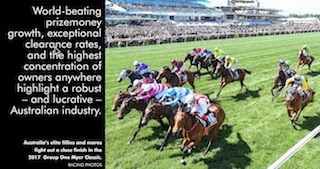
The total amount of available prizemoney for thoroughbred racing in 2016 in the three major European racing countries - Great Britain, France, and Ireland – was around US$488 million, for a combined population around 137 million.
In Australia, with 24 million people, the available prizemoney for the same year was $466 million. That is just one of a number of metrics that illustrate that horse racing in Australia is still much more a part of the fabric of contemporary society than is the case in the major flat racing countries of North America and Europe.
Australia is by no means the biggest; prizemoney in North America in 2016 was $1.083 billion, more than twice the amount of Australia. But in terms of horse racing’s reach into the general population, the current Australian model is streets ahead of those models evolved in what are traditionally the best racing countries.

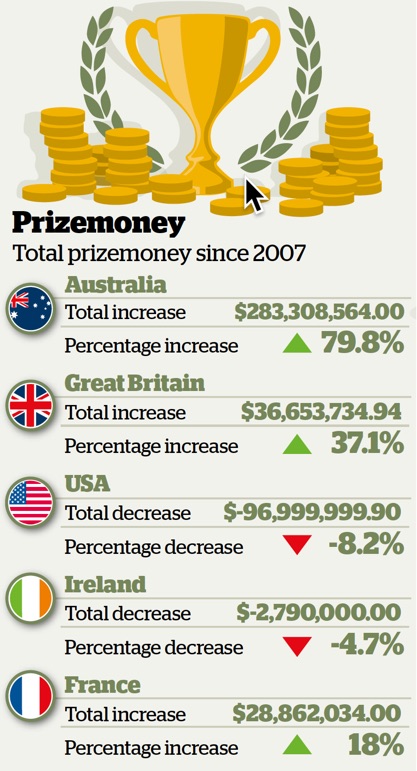
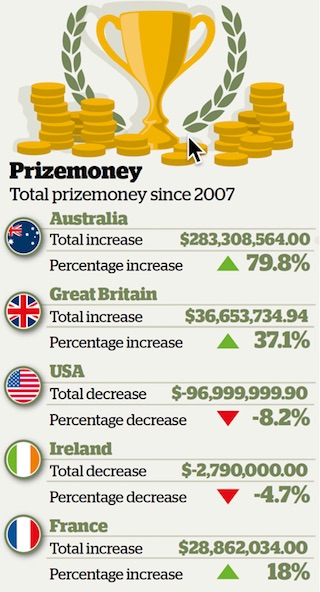
One way we can measure the success of Australian racing in the past 10 years is, in fact, in the percentage increase in prizemoney since 2007.
In Great Britain, from 2007 to 2013 prizemoney rose from £98 million to £112 million, or a little over 2% a year. Since 2013 that rate has increased to about 6% annually, and stood at £135 million in 2016, or a 37.1% increase since 2007. In France, with its very strong program of supplemental purses to encourage French-breds, the tenyear gain was 18%, from 160 million euros to 189 million euros. Ireland, where racing’s Celtic Tiger was the first to feel the effects of the crash in 2009, and in spite of double-digit gains the last two years, still had prizemoney 4.7% less in 2016 than in 2007; and in the US, prizemoney declined by 8.2%, nearly $100 million, from $1.18 billion in 2007 to $1.083-billion in 2016.
In the same time frame prizemoney in Australia increased by 79.8%, from $355 million in 2007-08 to $638 million in 2016-17.
Australia did not suffer the deep recession felt in Europe and America in 2007-2010, but even so this near 80% rise in prizemoney is mightily impressive.
Concomitant with the rise in prizemoney have been the increases at the Australian yearling sales in the four years since 2014. That year, according to figures produced by Aushorse, the marketing arm of Australia’s national Thoroughbred Breeders Association (TBA), there were 4,157 yearlings sold in Australia (that was an impressive 72.3% of the 5,595 catalogued), for a total of $267.5 million, and an average of $66,064. A slightly lower number – 5,519 – were catalogued at this year’s yearling sales. The number sold edged up to 4,236 (an even more impressive 76.7% of those catalogued). In three years the gross had leapt by 56%, to A$416.6 million, and the average by 49%, to $98,354. So the 2017 Australian yearling sales yielded probably the highest clearance rates in the known world even as its yearling market was essentially completing a three-year hike of 50% in receipts and average price. Pretty impressive.
Though individual prices may not be as high as what is recorded in Kentucky, Europe, or even Japan, prices are still impressively high, and what’s most impressive is that it’s not just happening by broadening the very top, often at the expense of other sectors, but is filtering down through all the deciles; in other words, it’s not just strong at the top, it’s strong all the way down the ladder. Because of the very high level of prizemoney, and the way it is distributed in the two biggest racing states, New South Wales and Victoria, there are much bigger incentives for ordinary people to be involved in racehorse ownership than in other major countries.
We can look at New South Wales as an example. The minimum purse in Sydney for Saturday meetings is $100,000, and they pay down to 10th. The minimum for Sydney weekday meetings is $40,000.
Then there are provincial meetings, with minimum purses of $30,000, and country meetings where the minimum purse is $20,000. Of course, these prizes are offset by the cost of buying the horses in the first place, and the cost of training them, which can be as much as A$50,000 a year, with the top trainers.
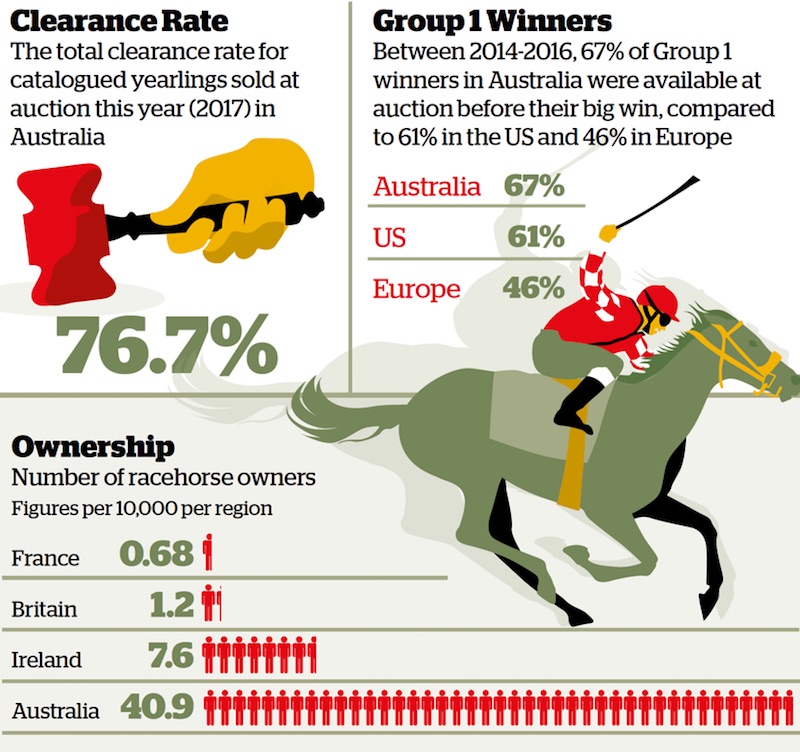

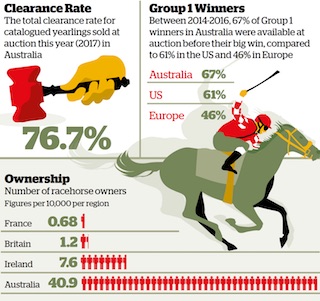
Especially through the evolution of syndicates (which have just had the cap on what they can spend raised from $250,000 to $500,000), coupled with the fact that horse racing is, as one observer put it, “just about” still a major sport (attracting column inches) in Australia, participation in racehorse ownership in Australia exists at levels the big northern countries can only dream about.
In Australia, according to Aushorse figures, a country of 24-million people there are 101,402 registered racehorse owners – one for every 244 people in the country. The only other major racing country you can even talk about in the same sentence is Ireland, where there are 3,663 owners among a population of 4.77 million; one owner for every 1,303 people, still only about one-fifth the ratio in Australia.
Great Britain has 7,946 owners among 65.6 million people (one in 8,260), and France has 4,575 owners among 66.6 million people (one in 14,561); and keep in mind, in Great Britain, Ireland, and France, a substantial number of those owners have jumpers, not flat horses. The USA is a country of over 350 million people yet they have only a third the number of owners as Australia; there are an estimated 35,000 racehorse owners in the USA, which works out to one in 10,000.
Let’s recap those numbers: Great Britain, one in 8,260; France, one in 14,561; USA, one in 10,000; Ireland, one in 1,303; and Australia, one in 244. Proportionally speaking, 40 times more people own racehorses in Australia, compared to the USA. The cost of training isn’t that much lower; the top trainers in Sydney will still cost $50,000 a year to train them.
But the availability of prizemoney, not just at the top but all the way down through the provincial and country meets, has also driven the substantial rises in the yearling markets, because again it is strong not just at the top, but all the way down the scale.
Since the economics of the horse business are in fact getting worse instead of better in the top European and North American markets – sure, it’s great if you have the right article, but it’s dramatically polarized, whereas in Australia the economics are better all the way down the scale – it’s easy to understand why racing in Australia is appealing to more and more people from the big northern racing countries: it’s fun, the racing is plenty competitive, and you have a real chance to share in a good horse and actually have a real chance, too, to make instead of lose money. When you look at the numbers, the appeal isn’t just obvious – it’s downright compelling.
